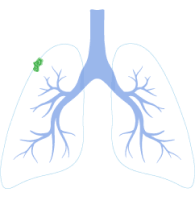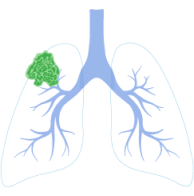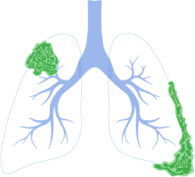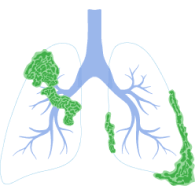Lung Cancer Survival Rate
Lung cancer survival rate describes how many patients are alive after a certain amount of time since being diagnosed. The general 5-year lung cancer survival rate is 18.6%, according to the American Lung Association (ALA). That said, it may be possible to outlive the average lung cancer survival rate with medical care. Learn more now.
What Is the Survival Rate of Lung Cancer?
Doctors will provide you with survival rate data after confirming you have lung cancer through diagnostic tests. Lung cancer has one of the lowest long-term survival rates, according to the ALA.
The overall 5-year lung cancer survival rate is 18.6%, meaning less than 1 in 5 patients are still alive 5 years after being diagnosed.
 That said, lung cancer survival rates can vary depending on the cancer stage, type, and individual patient health factors.
That said, lung cancer survival rates can vary depending on the cancer stage, type, and individual patient health factors.
Further, lung cancer survival rate statistics are estimates based on available patient data. It may be possible for you to live for many years or decades following a lung cancer diagnosis.
The best chance you have at outliving the average lung cancer survival rate is to get treatment. Lung cancer treatments can be very expensive, but you can afford them with our team’s help. Learn more now with a free case review.
- Access Financial Aid and Justice
- Learn About Your Options
- Contact Us for Free

Lung Cancer Survival Rate vs. Life Expectancy
Survival rates and life expectancies are two statistics doctors use to measure a lung cancer prognosis. However, the two terms are not the same.
Life expectancy is how long a doctor believes you’ll live given the type and stage of lung cancer you have. The overall life expectancy for lung cancer ranges from 7-16 months, but some patients can live for decades thanks to medical treatments.
Survival Rates by Lung Cancer Type
There are two main types of lung cancer, and each type has its own unique survival rate data available. View survival rates by type below.
Non-Small Cell Lung Cancer Survival Rates
Non-small cell lung cancer (NSCLC) is the most common lung cancer type, making up over 80% of all cases.
The overall 5-year survival rate for NSCLC is 26%, according to the American Cancer Society (ACS). Doctors can also diagnose cases of NSCLC into several subtypes, each of which has its own unique survival rate data.
- Adenocarcinoma: This is the most common subtype, being found in 40% of NSCLC diagnoses. This subtype forms in the glands that line the lings. The overall 5-year survival rate for this subtype is 12%, as noted by the U.S. National Library of Medicine.
- Large cell carcinoma: This is a catch-all subtype for cases that don’t easily fit into one of the other two subtypes. Only 7% of patients have this NSCLC subtype, and the 5-year survival rate is 19%, according to the journal Translational Lung Cancer Research.
- Squamous cell carcinoma: This subtype accounts for up to 30% of NSCLC cases and forms in the cells lining the lungs. The 5-year survival rate is 24%, according to Harvard Health Publishing.
Small Cell Lung Cancer Survival Rate
Small cell lung cancer (SCLC) is a less common type of lung cancer that grows and spreads faster than compared to SCLC. It represents 10%-15% of lung cancer diagnoses.
Patients with SCLC have an overall 5-year survival rate of only 7%, as noted by the ACS.
Get help after your NSCLC or SCLC diagnosis: Call (877) 446-5767 to learn more.
Survival Rates by Lung Cancer Stage
Survival rates also vary depending on lung cancer stage. Cancer stage allows doctors to track how far the cancer has spread through the body. Lung cancer survival rates are higher if the cancer stage is lower.
Here’s a breakdown of lung cancer survival rates by stage.


Stage 1 Lung Cancer Survival Rate
In this stage, lung cancer has not yet spread outside the lung. Roswell Park Comprehensive Cancer Center notes the 5-year lung cancer survival rate for this stage ranges from 70%-90%.
Stage 1 lung cancer patients typically have the most treatment options available, meaning there’s a better chance they’ll be considered cured and become long-term survivors.


Stage 2 Lung Cancer Survival Rate
The 5-year lung cancer survival rate in this stage is 50%-60%, according to Roswell Park Comprehensive Cancer Center.
Stage 2 lung cancer has spread to lymph nodes inside the lung, or there is more than one tumor in the same lung lobe. That said, treatments are still often available to help patients live longer.


Stage 3 Lung Cancer Survival Rate
By stage 3, the cancer has spread to nearby lymph nodes, and there is more than one tumor in a different lung lobe. The cancer spread limits available treatment options and thus lowers the overall survival rate.
The 5-year survival rate for stage 3 lung cancer is 20%-40%, as noted by Roswell Park Comprehensive Cancer Center.


Stage 4 Lung Cancer Survival Rate
Stage 4 lung cancer is the most advanced and thus, the survival rates are the poorest. The cancer has spread to the opposite lung, the fluid around the lung, or distant organs like the brain.
The ACS notes that the 5-year survival rate for stage 4 lung cancer is between 3% and 9%.
Afford treatments that can improve your lung cancer survival rate. Get started with a free case review.
- Access Financial Aid and Justice
- Learn About Your Options
- Contact Us for Free



Lung Cancer Survival Rate by Demographic
Besides the cancer stage and type, lung cancer survival rates may also vary depending on demographics like a patient’s sex, race, and age. See how below.
Sex of the Patient
Women have slightly higher lung cancer survival rates than men. The American Society of Clinical Oncology (ASCO) found that men have an overall 5-year lung cancer survival rate of 18%, while women have a 5-year survival rate of 25%.
Age of the Patient
Older lung cancer patients have lower survival rates, according to the National Cancer Institute’s Surveillance, Epidemiology, and End Results (SEER) Program.
Lung cancer patients under the age of 50 had a 5-year survival rate of 47.4%. By contrast, those aged 65 or older had a 5-year survival rate of 28.5%.
Race of the Patient
A 2018 study in the Journal of Thoracic Oncology revealed that race may also affect lung cancer survival rates. In the U.S., the national 5-year NSCLC survival rate is 15% among black people and 18% among white people.
Improving Lung Cancer Survival Rates With Treatment
Getting treatment gives patients the best chance of outliving the average lung cancer survival rate. This is especially true for those whose lung cancer is caught at an early stage.
Lung cancer treatments allow doctors to remove or destroy as much of the cancer as possible.
Lung cancer treatments that can influence survival include:
Chemotherapy
This treatment uses powerful chemicals to kill rapidly growing cells in your body, such as lung cancer cells.
Patients with metastatic NSCLC that received chemotherapy had a 5-year survival rate of 14% in a study from the Journal of Clinical Oncology.
Immunotherapy
Immunotherapy medications train the body so it can fight cancer.
The overall 5-year survival rate in metastatic NSCLC patients treated with the immunotherapy drugs Opdivo® and Yervoy® was 24%, according to the Journal of Clinical Oncology.
Radiation Therapy
Radiation therapy involves using types of radiation, such as X-rays, to kill cancerous cells. Different types of radiation can be used to help lung cancer patients.
Stage 1 NSCLC patients treated with stereotactic body radiation therapy (SBRT) have a 3-year survival rate ranging from 55% to 91%. Those treated with another type called radiofrequency ablation have a 3-year survival rate of 60% and a 5-year survival rate of 45%.
Surgery
Surgeons remove lung cancer tumors, along with the lung lobe or all of the lung that the cancer has grown into.
According to a 2021 Thoracic Oncology: Original Research study, the 5-year survival rate for lung cancer after surgery is around 65%.
Targeted Cell Therapy
This is a kind of cancer treatment that targets mutations and abnormalities in cancer cells that cause them to grow, divide, and spread uncontrollably.
The 1-, 3-, and 5-year survival rates for lung cancer patients treated with this therapy were 91.9%, 83.8%, and also 83.8%, respectively, in a 2021 study.
Learn how you can afford treatments to improve your lung cancer survival rate now: Call (877) 446-5767.
Find Help With Outliving Average Lung Cancer Survival Rates
Lung cancer is a devastating disease with low survival rates. Fortunately, you can increase your life expectancy by seeking treatment. Treatments can be expensive, but Lung Cancer Group is here to assist you.
Our team can help you file:
- Lung cancer lawsuits: Through a lawsuit, you recover compensation from manufacturers who used asbestos in their products if you developed lung cancer due to asbestos exposure.
- Asbestos trust fund claims: Trust funds can give those with asbestos-related lung cancer compensation for their medical bills and pain and suffering. Asbestos trust funds are legal entities organized through bankruptcy courts to pay negligent companies’ asbestos liability claims.
- Veterans benefits claims: Veterans with lung cancer may qualify for disability and health care benefits.
Get a free case review to learn more.
Lung Cancer Survival Rate FAQs
What affects lung cancer survival rates?
Many factors affect lung cancer survival rates, including what type of this cancer you have, its stage, your age, and your overall health.
Arguably, the best way to improve your lung cancer survival rate is to get treated. Without treatment, lung cancer can be deadly in months.
Is lung cancer always fatal?
No. While there’s not a universal cure for lung cancer, those diagnosed and treated in the early stages may be considered cured. These patients outlive typical lung cancer survival rates by years and decades.
Further, treatments like surgery and chemotherapy can possibly prolong your lifespan even if your cancer is not considered curable.
Does lung cancer go into remission?
Yes, in some cases. Lung cancer is more likely to go into remission — where there are no signs of the cancer — if you undergo multiple treatments and you were diagnosed and treated early.
Late-stage (metastatic) cancer that has spread to distant organs is less likely to go into remission. An oncology (cancer) health care provider can tell you if it’s likely that your cancer will enter remission.
What are some ways to improve the lung cancer survival rate?
You can improve your lung cancer survival rate by accessing proven lung cancer treatment options like surgery and radiation therapy, seeking financial compensation, and finding resources for lung cancer support.

